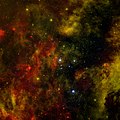File:Cygnus OB2.jpg

File originale (3 600 × 3 600 pixel, dimensione del file: 4,19 MB, tipo MIME: image/jpeg)
| Questo file proviene da Wikimedia Commons. La pagina di descrizione associata è riportata qui sotto. |
Dettagli
| DescrizioneCygnus OB2.jpg |
English: The Milky Way and other galaxies in the universe harbor many young star clusters and associations that each contain hundreds to thousands of hot, massive, young stars known as O and B stars. The star cluster Cygnus OB2 contains more than 60 O-type stars and about a thousand B-type stars. Deep observations with NASA’s Chandra X-ray Observatory have been used to detect the X-ray emission from the hot outer atmospheres, or coronas, of young stars in the cluster and to probe how these fascinating star factories form and evolve. About 1,700 X-ray sources were detected, including about 1,450 thought to be stars in the cluster. In this image, X-rays from Chandra (blue) have been combined with infrared data from NASA’s Spitzer Space Telescope (red) and optical data from the Isaac Newton Telescope (orange).
Young stars ranging in age from one million to seven million years were found. The infrared data indicates that a very low fraction of the stars have circumstellar disks of dust and gas. Even fewer disks were found close to the massive OB stars, betraying the corrosive power of their intense radiation that leads to early destruction of their disks. There is also evidence that the older population of stars has lost its most massive members because of supernova explosions. Finally, a total mass of about 30,000 times the mass of the sun is derived for Cygnus OB2, similar to that of the most massive star forming regions in our Galaxy. This means that Cygnus OB2, located only about 5,000 light years from Earth, is the closest massive star cluster. This composite image of the star cluster Cygnus OB2 contains X-rays from Chandra (blue), infrared data from Spitzer (red), and optical emission from the Isaac Newton Telescope (orange). |
| Data | |
| Fonte | http://www.spitzer.caltech.edu/images/5503-sig12-012-Probing-a-Nearby-Stellar-Cradle |
| Autore | X-ray: NASA/CXC/SAO/J.Drake et al, Optical: Univ. of Hertfordshire/INT/IPHAS, Infrared: NASA/JPL-Caltech |
Licenza
| Public domainPublic domainfalsefalse |
| Questo file è nel pubblico dominio perché creato dalla NASA. La politica sul copyright della NASA afferma che «il materiale della NASA non è protetto da copyright a meno che non sia specificato altrimenti». (NASA copyright policy e JPL Image Use Policy). |  | |
 |
Attenzione:
|
Didascalie
Elementi ritratti in questo file
raffigura
7 nov 2012
image/jpeg
Cronologia del file
Fare clic su un gruppo data/ora per vedere il file come si presentava nel momento indicato.
| Data/Ora | Miniatura | Dimensioni | Utente | Commento | |
|---|---|---|---|---|---|
| attuale | 23:10, 20 mar 2014 |  | 3 600 × 3 600 (4,19 MB) | Loridajose | User created page with UploadWizard |
Utilizzo del file
La seguente pagina usa questo file:
Utilizzo globale del file
Anche i seguenti wiki usano questo file:
- Usato nelle seguenti pagine di fr.wikipedia.org:
Metadati
Questo file contiene informazioni aggiuntive, probabilmente aggiunte dalla fotocamera o dallo scanner usati per crearlo o digitalizzarlo. Se il file è stato modificato, alcuni dettagli potrebbero non corrispondere alla realtà.
| Descrizione dell'immagine |
|
|---|---|
| Autore | Chandra X-ray Observatory Center |
| Titolo breve |
|
| Crediti | X-ray: NASA/CXC/SAO/J.Drake et al, Optical: Univ. of Hertfordshire/INT/IPHAS, Infrared: NASA/JPL-Caltech |
| Titolo | The Cygnus OB2 star cluster is about 5,000 light years from Earth and contains many massive young stars. |
| Fonte | Chandra X-ray Observatory |
| Data e ora di creazione dei dati | 8 nov 2012 |
| Larghezza | 3 600 px |
| Altezza | 3 600 px |
| Bit per campione |
|
| Meccanismo di compressione | LZW |
| Struttura dei pixel | RGB |
| Orientamento | Normale |
| Numero delle componenti | 3 |
| Risoluzione orizzontale | 300 punti per pollice (dpi) |
| Risoluzione verticale | 300 punti per pollice (dpi) |
| Disposizione dei dati | a blocchi (chunky) |
| Software | Adobe Photoshop CS6 (Macintosh) |
| Data e ora di modifica del file | 17:12, 7 nov 2012 |
| Versione del formato Exif | 2.21 |
| Spazio dei colori | sRGB |
| Informazioni di contatto | cxcpub@cfa.harvard.edu
60 Garden St. Cambridge, MA, 02138 USA |
| Parole chiave | Cygnus OB2 |
| Versione IIM | 4 |
